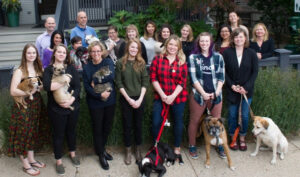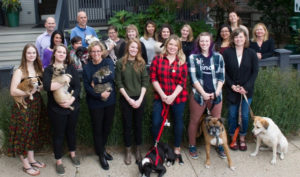Do you walk down the street and say “hello” to every stranger, introduce yourself and then, engage in playful banter? Recently, I’ve seen an uptick in clients expressing concern that their pet cowers or growls when a stranger reaches down to pet it. Obviously, these behaviors are not desired nor warranted. But, I wonder if we are asking too much of our canine companion to be gracious hosts all the time. Are we foolish to think all dogs desire to be friendly towards all strangers? I believe we may have set unrealistic expectations for many of our canine companions and are setting some dogs up for failure.
In pets, just like in humans, fear has a strong genetic component. Some animals are genetically programmed to fear their predators. Mice naturally fear cats. Elks are hardwired to fear wolves. It can also be the result of a learned experience. For example, if your dog slips every time it goes down your wooden staircase, eventually your dog is going to fear these slippery stairs.
I think it is unreasonable to ask every dog to happily greet strangers and comfortably play with other dogs. Ask yourself, “Do you like everyone you meet?” Please properly assess your dog’s personality. If your dog is fearful or shy, don’t allow strangers or other dogs to initiate an interaction with your non-receptive dog. This is very stressful for your pet and may likely lead to a negative consequence – a bite incidence! I believe most aggressive behaviors in dogs are fear based.
My 5 recommendations for a pleasant walk with your dog:
- Only engage in interactions with other dogs if both dogs desire this interaction. Do not allow this interaction to occur if it’s only your desire. If your pet has its ears down, has bristling of hair, or is shaking and hiding behind your legs, he/she does not want to interact with this new dog.
- If your dog cowers or growls when it meets people, he/she is telling you they don’t like meeting strangers. Be respectful of your dog’s personality and don’t let strangers pet your fearful dog.
- Before your pet engages in an interaction with a potential new dog friend, ask the other pet owner if their dog is “dog friendly” – meaning, it likes meeting new dogs and does not try to bite them if the playful behavior escalates in intensity. Only allow this new interaction to occur if you are completely comfortable with it. Listen carefully to how the dog owner responds to this question. If this person hesitates or puts caveats to their answer, then this is a red flag that your dog should not interact with this stranger’s dog. A poor interaction with one dog, can lead to a lifetime of fear towards others. Don’t set your pet up for a potential bad situation.
- If your pet is dog aggressive or has stranger anxiety, when you see a person or dog approaching your dog, just cross the street and avoid the problem. Try to encourage your dog to fixate on you as you cross the street and not the stranger or other dog. Distract your dog with a high value treat or toy. For fearful pets, avoiding an unpleasant interaction is your ultimate goal on every walk. As a respectful pet owner, you never want to reinforce negative experiences by testing each new interaction; will my dog like or dislike this new dog. Don’t find out. Be proactive and walk away.
- If your pet is dog aggressive or has stranger anxiety, seek professional help. Your veterinarian may recommend an animal behaviorist or trainer to help you and your dog live a stress-free life. Your veterinarian may also prescribe pharmaceutical products for your highly anxious dog to help it learn that life is not as scary as it imagines it to be. Talk to your veterinarian about anti-anxiety drugs, like trazodone, alprazolam or fluoxetine. Additionally, Zylkene and Solliquin are two of my favorite nutraceutical products that I like to use in mildly anxious pets. There is nothing shameful about helping your pet enjoy his/her best life with professional guidance.
So, the next time you take your pet for a walk, don’t forget to ask yourself these five questions before a stranger or dog approaches your pet. Next, carefully evaluate your answers and only then, do what’s in the best interest of YOUR dog.
I wish you all a pleasant dog walk!


